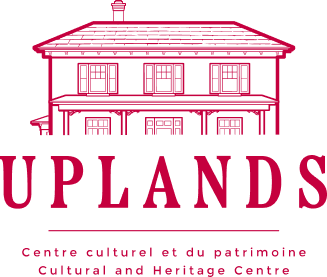Temporary Closure
Uplands Estate is currently closed for renovations.
Uplands Estate
The land on which the Uplands Estate is located is part of the unceded traditional territory of the Abenaki and Wabanaki Confederacy.
Designated as a heritage site by Sherbrooke in 2010, Uplands includes: the Uplands House (1862), the Red Barn (second half of the 19th century),
a wooded area featuring an outdoor exhibit on panels, and a garden embellished by two large sculptures.
Uplands House
Uplands is a Neo-Georgian heritage residence built in 1862 by John Barney Paddon, a gentleman farmer of British origin.
It is widely believed that he built the house according to the plan of his first residence “Uplands” in England, and that he gave it the same name. The house has been successively inhabited by the Paddon, Scarth and Speid families.
John Barney Paddon resided at Uplands with his second wife Emma Kellan and their 9 children until 1890. The house was then occupied by the daughter of John Barney Paddon, Julia Scarth, and her husband, the Archdeacon Archibald C. Scarth. Julia Scarth adored the Uplands gardens and improved the grounds. In 1919, the house was sold to Arthur Speid, a friend of the Scarth family. Twice-mayor of Lennoxville, member of the Lennoxville School Council, passionate photographer, actor and director in the regional theatre milieu, Arthur Speid was a pillar of the local community.
Janet Speid, daughter of Arthur Speid, was the last person to reside at Uplands. When she and her sister Catharine sold the house in 1987, they included in the deed of sale a condition according to which the integrity and historical character of the house would be preserved. She hoped that Uplands would become a useful place for the community.
Opening to the Public
In 1987, thanks to the financial help of the Ministry of Culture of Quebec, the Lennoxville-Ascot Historical and Museum Society (LAHMS) acquired Uplands jointly with the town of Lennoxville. With the help of volunteers who devoted hundreds of hours of work to renovate and restore the buildings, Uplands opened its doors to the public in 1988.
In 1999, LAHMS sold its share of the property to the Town of Lennoxville at the symbolic price of $1. Following the fusion of Lennoxville with Sherbrooke in 2000, the Uplands site became the property of the City of Sherbrooke. The city took charge of the maintenance and upkeep of the buildings and LAHMS continued to occupy the premises.


Opening to the public
In 1987, thanks to the financial help of the Ministry of Culture of Quebec, the Lennoxville-Ascot Historical and Museum Society (LAHMS) acquired Uplands jointly with the town of Lennoxville. With the help of volunteers who devoted hundreds of hours of work to renovate and restore the buildings, Uplands opened its doors to the public in 1988.
In 1999, LAHMS sold its share of the property to the Town of Lennoxville at the symbolic price of $1. Following the fusion of Lennoxville with Sherbrooke in 2000, the Uplands site became the property of the City of Sherbrooke. The city took charge of the maintenance and upkeep of the buildings and LAHMS continued to occupy the premises.
Uplands Cultural and
Heritage Centre
Uplands Cultural and Heritage Centre was created in 2000 with the mandate to animate and manage the Uplands site and its activities. Who are we?
Lennoxville-Ascot Historical
and Museum Society
The Lennoxville-Ascot Historical and Museum Society manages a collection of over 6000 objects as well as a small Archives Centre located inside the Uplands house. LAHMS organizes historical exhibitions and events designed to present and preserve the history of Lennoxville-Ascot.


